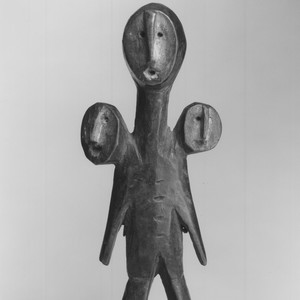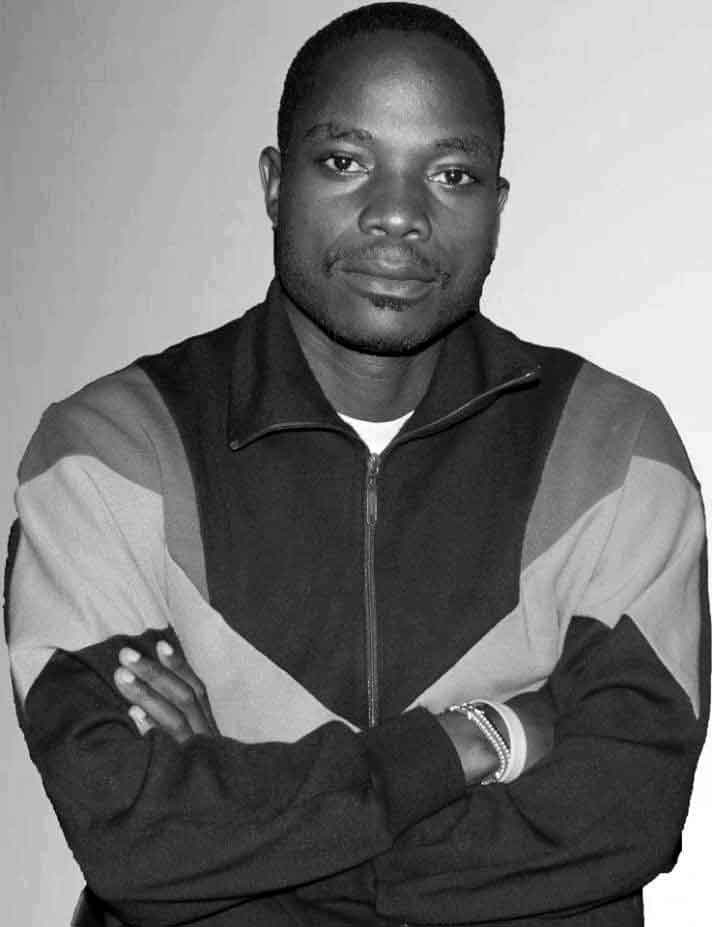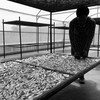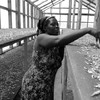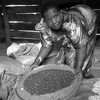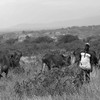The Angololo Project: Set to transform lives in Uganda and Kenya
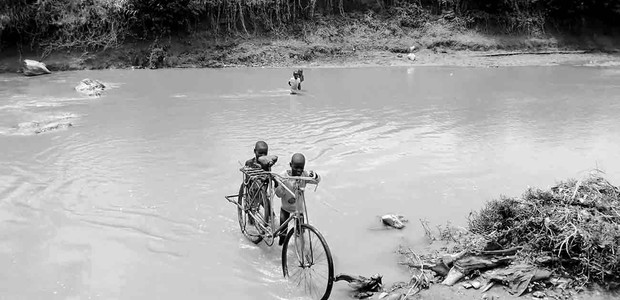
The hot sunny ride on a dusty road through the bushes of Osajai in Kenya’s Teso North region leads you to a 50-meter-wide river called Malaba, which separates Kenya and Uganda. In Kabwin village, a group of men and women installs a manual pump in a new community borehole to save them from walking long distances searching for clean drinking water from other villages. The river water is dirty due to siltation and human and livestock activities.
While some men are harvesting sand from the middle of the river, others, including women and children as young as five years old, carry luggage on their heads, walking through the water to either side. On the riverbank, a few women are scavenging for green vegetables in the dry gardens, others fetching firewood. Young boys cross with cattle from the Uganda side to graze in the open fields on the Kenyan side.
The long dry season has left communities along the river to struggle for survival as the river is almost empty, with some areas filled with pebbles and sand, if not heavy mud. Women fetch water in jerry cans to water their struggling vegetable gardens every morning and evening.
The situation, however, is quite different when rains come. Then, most flat farms near the river are swallowed by water, rendering movement difficult. There is no bridge to cross the river. The water breaks the banks, sweeping away vegetables and cassava plantations.
The Malaba River, also known as Komiriai, Lwakhakha or Manafwa, stretches from Mount Elgon down to Lake Victoria, separating a group of people who speak the same language and share the same culture but who have different nationalities.
The river is the primary source of livelihood for communities in both countries. Smuggling goods across it is a significant illegal economic activity, as there is no formal migration office upstream, apart from the Malaba town border point.
For many years, the risky business has led the authorities in Kenya and Uganda to deploy police patrols along the river to arrest the smugglers and impound smuggled goods. Many have died in the river trying to evade arrest.
Sugar, wheat flour, energy drinks, cooking oil, and soap are the everyday items Ugandans get from Kenya, while Kenyans get textile, cereals, eggs, farm inputs and electronics from Uganda.
Many people have
been swallowed by
this river.
“We get our fish, pork, and vegetables from Uganda, and when the river is full, there is no way you can cross. Many people have been swallowed by this river while trying to cross, especially at night,” said George Enamba, a resident of Kabwin village.
Many Kenyans who have died include men and women crossing to the Uganda side to buy cheaply locally made brew, popularly known as Chang’aa in Kenya or Waragi in Uganda. “Chang’aa is illegal in Kenya, but in Uganda, it is not. We cross there to drink, but you have to drink keeping in mind that you have a big river to cross”, said Steven Wanjusi who has just crossed over from Uganda.
Farming along the Malaba River has been challenging during heavy rains. “There is no way to get vegetables when it rains because all these farms get flooded. So, we have to cross to Uganda, and when the river is full, you cannot cross,” said Lillian Nanjala, a young mother whose farm borders the river.
Young men near the river harvest sand, which is risky and destroys the river, allowing water to break the soil and carry it away downstream.
The Angololo Water Resource Development Project
There is good news for residents in Kabwin and Kalait villages following a multi-million cross-border project commissioned to transform lives and create employment in the area. Located on the transboundary Malaba River between Kenya and Uganda, the project falls within the Sio-Malaba Malakisi River Basin.
The USD 1.65 million project funded by the African Development Bank (AfDB) was launched in July 2019, with both Kenya and Uganda contributing USD 150,000 each to facilitate the construction of a composite rock-fill concrete gravity dam that will generate electricity, provide piped water, as well as improve livestock and fish production that will serve the people of Tororo, Manafwa and Namisindwa districts in Eastern Uganda, and the people of Busia and Bungoma counties in Kenya.
Kenya and Uganda collaborated with the Nile Equatorial Lakes Subsidiary Action Program (NELSAP), one of the three centres of the Nile Basin Initiative (NBI), through the Sio Malaba Malakisi River Basin Management Project. NELSAP conducted pre-feasibility studies in 2010, with grants from Sweden and Norway. Following this study, the government of Kenya and Uganda requested NELSAP to add it to its national resources projects slated for further development.
The project will
sustainably improve
both countries’
social-economic
development.
The project coordinator, Eng. Sami Osman says the feasibility study, which commenced in 2019 and is expected to end this year, details the design and tender documents.
“The project will sustainably improve both countries’ social-economic development,” he said. “There will be water resources development and management, encompassing flood mitigation in the Malaba River, irrigation development, electricity generation, fisheries development, and domestic and livestock water supply.”
Meanwhile, the Tororo District Water Officer, Leo Adongo Owora, says the project will help transform people’s livelihoods in Angololo and Mera in Uganda and the surrounding communities in Kenya, allowing people to plant crops throughout the seasons.
“If the dam is built, it will solve water challenges residents grapple with. Water will be stored in the multipurpose reservoir,” he said. “The road constructed on top of the dam will enable people in cars and motorcycles to cross safely from Uganda to Kenya.”
He added that the project would help mitigate floods that generally happen in March, April, September, October, and November.
The 30-meter high dam with a catchment area of 444 square kilometres and a reservoir capacity of 43 million cubic metres will provide 3,854 hectares with irrigation, generate 1.2 megawatts of electricity and connect 270,000 people in Kenya and Uganda to piped water.
Initially, six locations were identified for the dam construction. However, after thorough investigations by the consultant, only two possible locations remained. These include dam site five and dam site six. But the latest review of the feasibility study revealed that both Uganda and Kenya agreed that the dam is constructed at site five, which is precisely in Mera Sub-County in Tororo Uganda, and Osajai and Kamuriai location in the Teso north of Busia County in Kenya.
Resettlement plan
People whose land will be used will be compensated to enable them to relocate to other places. Residents of Kabwin village already see this as an opportunity. “I see this project will change our lives. If I am paid the money, I will move away and invest somewhere and start a business. Those staying will have water in their homes, which will help them plant vegetables for sale through irrigation,” says Robert Karani, a Kenyan sand harvester.
Another sand harvester, Moses Amai, hopes that he will abandon sand harvesting and get a permanent job when the project starts. “Here, we have no development. We rely on the sand and in a day, you can just manage one lorry. I know if the project comes here, we shall start earning good money. We welcome the construction of the dam.”
But Lillian fears her family will not benefit once they are relocated. “They told us that we shall be moved from here, so my question is, if we move, how shall we benefit from the project because we may not get another land near to the project?”
Peter Kutosi from Uganda also voiced uncertainty: “Yes, we like the project, but we don’t know if it comes. Will they chase us from harvesting sand, or they will allow us to continue?”
If we move,
how shall we
benefit from
the project?
On his part, Edwin Ken is happy that once the water is connected to homes, he will not be taking cows to the river. “This dam will be a good thing. I am from Uganda, not Kenya, so if they can construct the dam and bring water to homes, our cows will not fall in the water and be taken away like it has been happening. I pray that the government starts constructing.”
Samuel Imaa, a resident of Bunekesa Zone in Bwasiba Parish, Namboko Sub-County in Namisindwa District of Uganda, is worried about his dead ancestors. “I have two pieces of land which the project will take. One is a customary land neighbouring the Malaba River in Tororo District, and the other piece of land is in Namisindwa District. One of the lands is a graveyard. I need a reasonable compensation to look for ample space to relocate the graves of my beloved ancestors.”
In terms of bargaining, he added: “We shall not allow any middlemen to come and interact with us. Middlemen and politicians tend to interfere in project compensation negotiations to cheat vulnerable people.”
The Principal Assistant Secretary of the Tororo District, Jackson Osido, said there is a clear plan to sensitise the community social and commercial officers to guide the residents on how to utilise their money. The extension workers will also be taught modern agronomic practices to help them sustainably produce goods and services.
For Angololo residents who will be relocated after compensation, he said, they may choose to buy or hire land in the adjacent areas. “The land valuers are on the ground checking the assets for all the project affected persons. People living on the 444 square kilometres will be resettled and compensated according to their assets.”
The resettlement action plan involves stakeholders from Kenya and Uganda in the affected areas of Tororo, Manafwa, Namisindwa, and Busia. It will be submitted to the respective National Environment Management Authority (NEMA) in Kenya and Uganda to get the value of each compensation depending on the individual assets, including trees, livestock, houses, gardens, land acreage, etc.
Besides generating hydropower and supplying water, Joseph Papa requests a new tarmac road and bridge to boost the local economic growth in the area. The population often depends on dangerous smuggling for survival, and Osido said the dam would create a passage so that people go through the formal channels instead of smuggling. He urged the respective governments to “create a mini entry point”.
Challenges
According to Eng. Osman, the project was slowed by the global Covid-19 pandemic. For the project to be implemented, the project implementation unit, with the help of NELSAP, will seek to mobilise resources from development partners such as the African Development Bank and the World Bank.
“There is a gap between one and two years to conduct donor-roundtables to get funds from the development partners to implement the study. We expect the construction of the dam to start either at the end of 2023 or the beginning of 2024,” he said.
Once the preparatory studies are finalised, the two countries will form a project management unit to supervise the implementation of the project.
We shall have
enough money
to buy beer here.
But for local people like George Enamba, excitement is mounting about the new era. “When we get electricity here, our children will start producing metal doors and windows. Mothers will not struggle to cross the river to look for vegetables on the other side because they will be growing a lot.”
For now, Wanjusi said, he continues to risk his life crossing to Uganda to drink Chang’aa. “We go to Uganda to drink. That’s all. But if the project comes, we shall have enough money to buy beer here, and young men will stop sneaking across and being arrested and jailed.”
